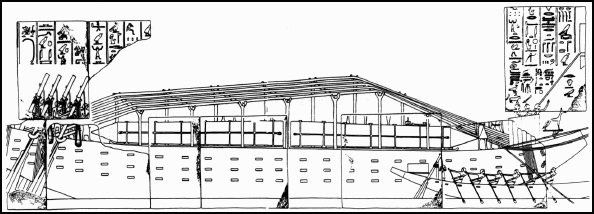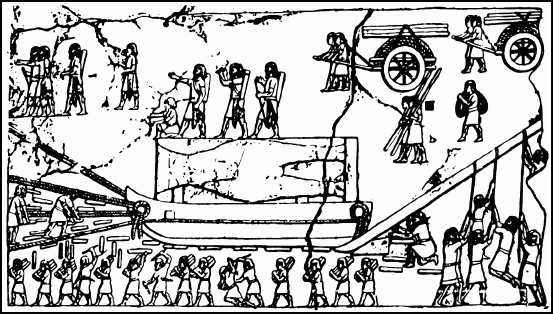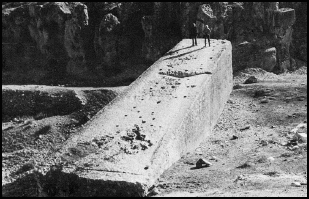
The heaviest known blocks to be brought from Aswan to Giza were the massive granite stones used for the roof of the King's Chamber in the pyramid of Kufu. Each weighed about 50 tons. 5th and 6th Dynasty pyramids included gabled roofs with blocks weighing up to 90 tons. The mortuary temple of Menkaure included limestone blocks weighing 200 tons. In the 18th Dynasty, two colossal statues of Amenhotep III (the "Colossi of Memnon"), each weighing more than 700 tons, were moved an overland distance of 700 km. Fragments of statues in the Ramesseum (built under Ramesses II) suggest an original weight of 1,000 tons. How was it possible for objects of this size to have been moved?
Hatshepsut's obelisk barge.

Herodotus described moving the 580 ton "Green Naos" under Nectanebo II: "This took three years in the bringing, and two thousand men were assigned to the conveying of it ..." (History, 2.175) Pliny wrote of the transportation of an "eighty cubit" obelisk under Ptolemy II:
According to some authorities, it was carried downstream by the engineer Satyrus on a raft; but according to Callixenus, it was conveyed by Phoenix, who by digging a canal brought the waters of the Nile right up to the place where the obelisk lay. Two very broad ships were loaded with cubes of the same granite as that of the obelisk, each cube measuring one foot, until calculations showed that the total weight of the blocks was double that of the obelisk, since their total cubic capacity was twice as great. In this way, the ships were able to come beneath the obelisk, which was suspended by its ends from both banks of the canal. The blocks were unloaded and the ships, riding high, took the weight of the obelisk. (Natural History, 36.14)
Moving a statue in 12th Dynasty Egypt.

Moving large stones over land was more involved. Sledges and rollers (the latter being of a more limited value) were available in pharaonic times, and workers were in great supply. Friction was the main obstacle. An 800 ton block measuring 4x4x20 m would create a ground pressure of 1 kg over each square centimeter of its base. A force of at least 400 tons would be required to overcome the friction. Modern engineers working under primitive conditions found that, while moving blocks weighing 6 tons on a sledge, friction could be reduced to nearly zero by wetting the track with a lubricant (in this case, water). In the relief pictured above, from the tomb of Djehutihotep, a man can be seen on the leading end of the sledge pouring a liquid on the ground in front of it. Modern reenactments also demonstrated that a friction "seal" is formed beneath a static load that is broken when the load begins to move. An Assyrian relief (below) shows the use of a lever at the back of the sledge, possibly used to break such a "seal," or perhaps to propel it forward.
Moving a stone in Assyria.

It has been estimated that a ratio of two men per ton would be required for moving loads over flat surfaces; nine men per ton would be required for moving loads up a 9° slope. Practical experiments moving loads on a sledge over a lubricated track have shown that one man could pull one ton. Thus, the 1,000 ton colossus of Ramesses II could have been moved by 1,000 men (or 200 oxen).
The movement of large stones was not confined to Egypt in ancient times. The Romans moved the so-called Trilithon, weighing 800 tons, from the quarry to the Temple of Jupiter at Baalbek (in eastern Lebanon) in the first century AD. Another stone weighing 1,200 tons, the Hajar el Hibla ("Stone of the Pregnant Woman"), was never separated from its base and lays abandoned. Though the Romans left no record of their methods, it is obvious that the Egyptians did not have a monopoly on any "secret" technique of moving large stones.
The "Stone of the Pregnant Woman,"
at the quarry near Baalbek.

© Copyright Friedrich Ragette, Baalbek, p. 114
It has been claimed by some that moving the largest of the Egyptian blocks would be beyond our modern-day technological capacity, even with the use of cranes and other heavy equipment. Such arguments are false. In 1999 it became necessary to move the 208-foot tall Cape Hatteras lighthouse to a location more than a half-mile away. The lighthouse weighs 4,830 tons and had to be moved in one piece in its upright position. How was this achieved?
Moving the Cape Hatteras lighthouse.

© Copyright U.S. Department of Transportation
The use of cranes was impractical, and the actual technique used was very similar to that ascribed to the ancient Egyptians. First, the lighthouse was undercut and shored using timber (see photo below). One hundred hydraulic jacks were installed on rollers to slide along steel track beams placed beneath the lighthouse. A road was made by compacting the natural sands, overlaid with crushed stone, and finished with steel mats. Five hydraulic push jacks slowly shoved the lighthouse along the track beams in five-foot increments. The track was lubricated with soap shavings to reduce friction. The move, from start to finish, took 23 days.
Wood shoring
beneath lighthouse.

National Park Service photo
With hydraulic machinery to replace human and animal muscle, and hardened steel substituting for wood, it is well within our modern-day ability to perform the mechanics of constructing the Great Pyramid. What we lack today is the motivation to put the plan into effect and the resources to carry it out, both abundant in ancient Egypt during the Pyramid Age.
Catchpenny Mysteries © copyright 2000 by Larry Orcutt.
link